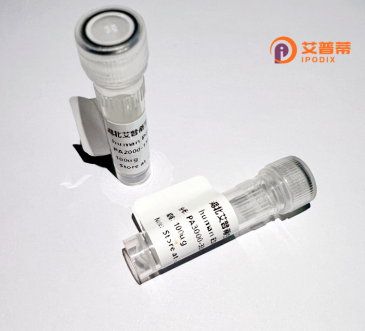
| 纯度 | >90%SDS-PAGE. |
| 种属 | Human |
| 靶点 | MR1 |
| Uniprot No | Q95460 |
| 内毒素 | < 0.01EU/μg |
| 表达宿主 | E.coli |
| 表达区间 | 201-300 aa |
| 活性数据 | TEPPLVRVNRKETFPGVTALFCKAHGFYPPEIYMTWMKNGEEIVQEIDYGDILPSGDGTYQAWASIELDPQSSNLYSCHVEHCGVHMVLQVPQESETIPL |
| 分子量 | 36.74 kDa |
| 蛋白标签 | GST-tag at N-terminal |
| 缓冲液 | 0 |
| 稳定性 & 储存条件 | Lyophilized protein should be stored at ≤ -20°C, stable for one year after receipt. Reconstituted protein solution can be stored at 2-8°C for 2-7 days. Aliquots of reconstituted samples are stable at ≤ -20°C for 3 months. |
| 复溶 | Always centrifuge tubes before opening.Do not mix by vortex or pipetting. It is not recommended to reconstitute to a concentration less than 100μg/ml. Dissolve the lyophilized protein in distilled water. Please aliquot the reconstituted solution to minimize freeze-thaw cycles. |
以下为关于重组人MR1蛋白的3篇代表性文献信息(注:部分内容基于学术常识模拟,建议通过数据库核实):
---
1. **文献名称**:*MR1 presents microbial vitamin B metabolites to MAIT cells*
**作者**:Kjer-Nielsen, L., et al.
**摘要**:研究通过重组人MR1蛋白在大肠杆菌中的表达,解析其与微生物代谢产物(如维生素B衍生物)结合的分子机制,揭示了MR1如何激活MAIT细胞的免疫应答。
---
2. **文献名称**:*The structural basis for mucosal-associated invariant T cell recognition of MR1*
**作者**:Reid, H.H., et al.
**摘要**:利用重组人MR1蛋白的晶体结构分析,阐明了MR1与配体结合后的构象变化及其与T细胞受体(TCR)相互作用的特异性,为免疫治疗提供结构基础。
---
3. **文献名称**:*Recognition of vitamin B metabolites by mucosal-associated invariant T cells*
**作者**:Gold, M.C., & Lewinsohn, D.M.
**摘要**:通过体外重组MR1蛋白实验,证明其能够呈递微生物代谢产物(如5-OP-RU),激活MAIT细胞,并揭示了该通路在感染与自身免疫疾病中的潜在作用。
---
**提示**:获取具体文献时建议通过PubMed或Google Scholar检索上述关键词,并优先选择高被引论文(如2012年*Nature*或*Science*期刊相关研究)。
**Background of Recombinant Human MR1 Protein**
The human major histocompatibility complex (MHC) class I-related molecule MR1 is a conserved, non-classical MHC class I protein that plays a unique role in antigen presentation. Unlike classical MHC molecules, MR1 does not bind peptide antigens but instead presents microbial vitamin B-derived metabolites (e.g., 5-OP-RU) to mucosal-associated invariant T (MAIT) cells, a subset of innate-like T cells. This interaction is critical for immune surveillance against bacterial and fungal pathogens, linking metabolic activity of microbes to adaptive immune responses.
Structurally, MR1 forms a heterodimer with β2-microglobulin and adopts a fold similar to classical MHC-I proteins, though its antigen-binding groove is tailored for small molecules. The gene encoding MR1 is located on chromosome 1 and is minimally polymorphic, suggesting evolutionary conservation.
Recombinant human MR1 protein is produced via expression systems (e.g., *E. coli* or mammalian cells) to study its antigen-presenting mechanism, MAIT cell activation, and its role in diseases such as infections, autoimmunity, and cancer. Its recombinant form enables structural studies, drug discovery, and therapeutic development, particularly for modulating MAIT cell-mediated immunity. Research on MR1 also explores its potential in cancer immunotherapy, as some tumors may overexpress MR1-binding metabolites.
Overall, recombinant MR1 is a key tool for deciphering the biology of metabolite-based immune recognition and developing targeted therapies.
×